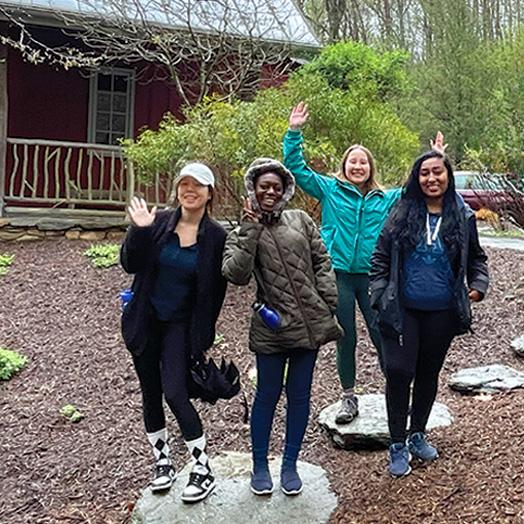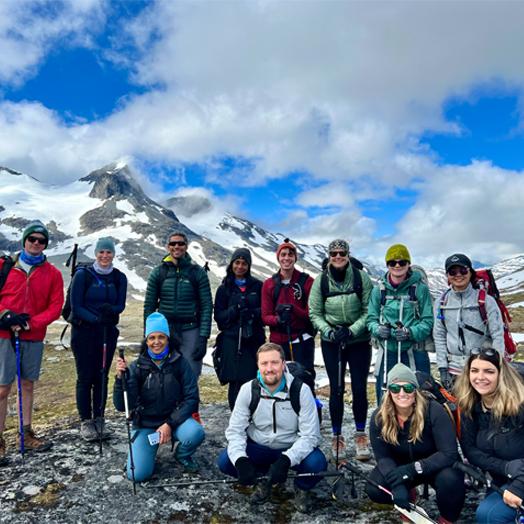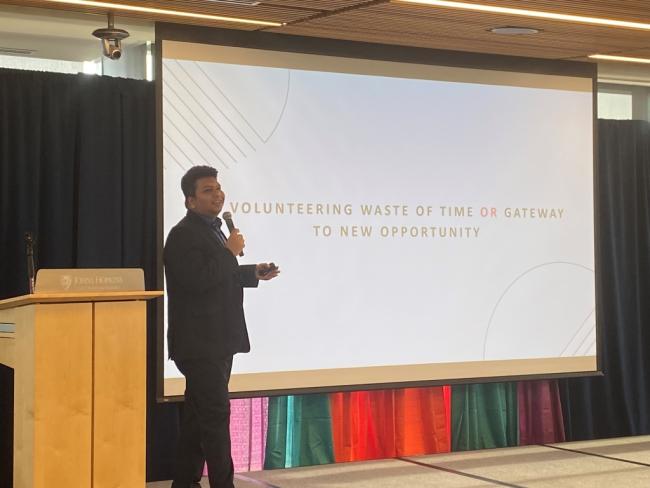A weekend in the woods usually means a break. For this group, it meant getting to work in a more connected way.

Women head to the woods to tackle leadership and sustainability
When a group of women from Johns Hopkins Carey Business School converged for a weekend in the woods recently, they came home with much more than bug bites and campfire stories.
Fourteen students from Carey’s Women in Business and NetImpact student groups gathered at Thorpewood, a 156-acre mountain property in Thurmont, Maryland, created to nurture relationships with the natural world in ways that promote empathy and restoration. At first blush, the weekend might sound a bit more like Eat Pray Love than Leaders Eat Last. Nothing could be further from the truth.
“We wanted to talk about owning our power and supporting women in the workplace,” said Meijie Liao, a part-time MS Marketing student graduating in August. “Not seeing other women as competition, but finding out how we can effectively team up and develop skills that create a context around leadership that’s not focused on male-dominated narrative, to put ourselves in the leadership positions and proactively explore how we can contribute to create change.”
The combination of female leadership and the sustainability that a weekend at Thorpewood implies was no coincidence. Liao and her co-organizers for the retreat, Flexible MBA student Sarenka Smith and Carey Assistant Director of Student Engagement Wendy Crowley, decided early in the planning process that they wanted an experience focused on something related to the environment. It aligned well with the emergence of environmental, social, and corporate governance issues, or ESG, in business. So, they developed an agenda, then worked with Hopkins professor and environmentalist Paul Kayzak and his sustainability leadership co-leader, Kimberly Wilson, to hone it. Soon they had a plan that centered on food sustainability.
“The vision statement was very much about the gap in female leadership around sustainability topics and how we can have a stronger voice,” said Crowley, who represented the Office of Student Affairs’ engagement team in the collaboration. “What are the issues that are most prevalent? What are some possible solutions? How can we learn skills to be leaders around this big topic?”
Liao was a natural. A passionate cook whose 18,000-follower Instagram account focuses on food, food sustainability, and immigration, she has built a personal brand around the subject.
“Often, the burden of food sustainability falls on women, whether it’s in the supply chain working on a form or preparing the food,” she said. “We talked about the role that women play as leaders in this space and as investors in ESG. The ways they’ve used sustainability and labor are different from other fields where it’s more male-dominant, like finance and venture capital. Women are much more likely to put their time, energy, and money into it, and perceive lower risks when it comes to sustainability initiatives.”
To avoid a lecture-heavy program, the planners incorporated leadership competencies, styles, and purpose with nature walks, practical team-building games, and immersive settings—like discussing sustainability innovation in the lodge because the builders used innovative sustainability in everything from the choice of wood to the way the structure is heated and cooled. Liao spearheaded a learning experience on reducing food waste that involved hiking, foraging, learning about native foods in the local ecosystem, and understanding how being part of an ecosystem informs a person’s lifestyle.
For other students, the sustainability focus was new. But that didn’t dissuade them from being enthusiastic and adventuresome campers. Smith led an experience on “fast fashion” – the environmental impact of supply and demand for runway-inspired clothing at affordable prices during fashion seasons.
“Everyone came with a very open mind, and I so appreciated that,” said Smith. “I don’t think it would have worked as well if they hadn’t. We are all such different people.”
As is the case in building a business team, differences proved to be positive. After a hands-on learning day, an activity called “Story of My Life” encouraged the women to share things about themselves that couldn’t be found on a résumé or a LinkedIn profile. The result was a powerful encounter with intimacy, emotion, and vulnerability. In one day, they’d established individual understanding, solved programs in groups, and gained an indelible lesson in the value of human connection.
“Emotional intelligence is critical in facilitating good leadership,” said Smith. “I don’t know if that’s inherent to women, but I think the act of connection and trust and intimacy allows you to know other people better and allows self-reflection, introspection, and self-awareness. I firmly believe that great leaders are deeply introspective.”
What to Read Next

experiential learning
Carey Business School students trek through Norway to grow leadership skillsUnwittingly, the group started putting empathy into action as soon as they’d convened. One participant was a new mother who wanted so badly to be part of the Thorpewood experience that she brought her five-month-old along. The group immediately started sharing the support it took for the new mom to be there.
“That was a tremendous addition to the team experience and really shifted the dynamic of what we were doing,” Smith said. “To have the lens and perspective of someone who’s new to the world and has a genuine sense of joy was so rejuvenating, but also understanding a sense of proactive care and sharing of responsibility where people were really trying to step in brought me so much joy and affirmed that we built an effective and supportive team.”
In planning the weekend, Smith and Liao may have also led something else: a framework for replication. Carey’s student groups had never planned an experience like Thorpewood before, but now, Crowley says, there will be another one next year, the focus for which will be revealed in the fall.
“I think these women possibly have friends for life,” she said. “And I think left really knowledgeable about the serious problems we have. Here we are in this beautiful place understanding the creek that we were looking at was very different 30 to 50 years ago. We’ve lost species. The trees have changed. That’s what I loved about it. I wasn’t just hearing about these things. It was being there and talking about how women might lead the way in fixing it.”


